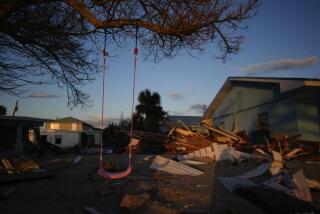Hurricane Ike victims still homeless, 2 months later
OAK ISLAND, TEXAS — Truong Van Cao and two other fishermen share a cramped, muddy tent amid the wreckage of homes, including his own, destroyed when Hurricane Ike stormed across this tiny southeast Texas town.
Seventy miles to the northeast, Bridge City retirees Ferrel and Jerry Ashby waited a month to get a mobile home from the Federal Emergency Management Agency after the storm flooded their house.
On Galveston Island, the bull’s-eye for Ike’s arrival, Roshonda Domingeaux and her family have bounced from shelter to shelter since the 12-foot storm surge destroyed her house.
Two months after Ike struck, finding housing is still an agonizingly slow process in this swath of Gulf Coast that relies on the petrochemical industry and fishing for its lifeblood.
Housing was already tight. Still reeling from 2005’s Hurricane Rita, the region began to enjoy a $16-billion expansion of its refineries, including a $7-billion project that will turn Motiva Enterprises LLC’s plant in Port Arthur into the country’s largest refinery. That meant up to 18,000 new workers looking for places to live.
“We’ve had housing issues the last two years due to the influx of contractors for all this construction going around here,” said Bridge City Mayor Kirk Roccaforte.
That, in effect, was a good-news housing shortage. But then Ike barreled ashore on Sept. 13, leaving thousands more homeless.
And to no one’s surprise, local officials and residents say FEMA has been slow to respond with the mobile homes it promised to provide. The federal agency promised officials recently that it has worked hard to cut the red tape and that housing remains its No. 1 priority.
In Bridge City, a blue-collar community of petrochemical workers, Ike damaged nearly 90% of the 3,400 homes.
The Ashbys, both 70, had hoped they could stay nearby in a hotel or rent an apartment or home while they repaired their house. But the closest vacancies of any kind were in Houston, 100 miles away.
“There just wasn’t anything,” Ferrel Ashby said. The couple ended up sleeping on their son’s couch at first, then in a tiny travel trailer he used for fishing trips.
Jerry Ashby said the only way repairs to his home could move forward would be if he and his family lived on-site in a FEMA trailer. So he and his wife remained patient during the month it took for their mobile home to arrive.
They never considered staying in Houston as a viable housing option.
“I would rather have lived in a tent,” he said.
Van Cao, 48, sent his wife and daughter to Houston, about 60 miles to the west, but he also felt he had no choice but to stay where he was after Ike. He couldn’t leave Oak Island, home to some 300 people on the shores of Trinity Bay, unless he wanted to quit his crabbing job.
“I have to survive,” the Vietnamese immigrant said.
Van Cao received a FEMA trailer, but the utilities hadn’t been hooked up.
So after spending 13 hours each day fishing, Van Cao returns to a cramped tent filled with cots and clothes he shares with two other fishermen. Two others lived in a smaller tent and a sixth lives in a nearby minivan.
Their kitchen is a wooden table, partly covered by blue tarp, with a small gas stove and stacks of canned goods. Recent showers have filled their improvised campground with mud and mosquitoes.
Earlier this month, FEMA Administrator David Paulison and Homeland Security Secretary Michael Chertoff visited southeast Texas, promising to get trailers much more quickly to residents.
“We have plenty of units. It’s finding the spots,” Paulison said. “As we are finding the spots, we are putting them down very quickly. We are going to see this process really start taking off.”
FEMA spokesman Simon Chabel said local zoning regulations and getting waivers allowing trailers to be placed in floodplains had slowed the process. He also said FEMA had provided more than $294 million in housing assistance for repairs and rental assistance.
The U.S. Small Business Administration also issued $253 million in low-interest loans for home repairs.
“It’s unfortunate we can’t drop houses overnight on people who need them,” he said.
As for Domingeaux, whose family has been in shelters in Galveston and San Antonio, she felt forgotten by and frustrated with FEMA, but she’s hopeful things are about to change.
“They took too long to help us. The hardest part has been having to tell my child she doesn’t have a home to live in,” Domingeaux, 25, said as she held her 3-year-old daughter, Viviana, outside her current home, a privately run tent shelter in Galveston.
After initially getting rejected by FEMA, Domingeaux has now been approved a hotel for her family.
“They say we’ll be getting a trailer in two or three weeks,” she said. “I feel a whole lot better now.”
More to Read
Sign up for Essential California
The most important California stories and recommendations in your inbox every morning.
You may occasionally receive promotional content from the Los Angeles Times.










